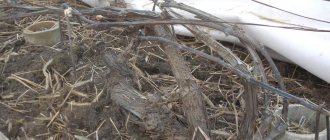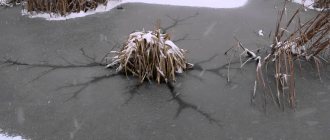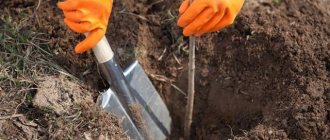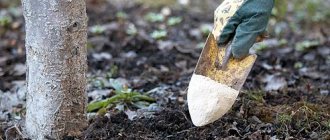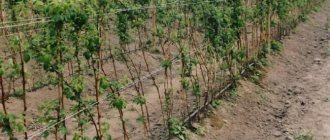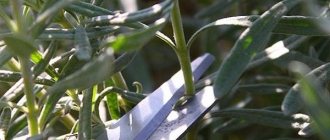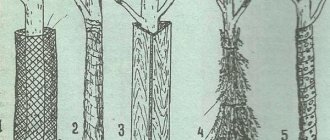Preparing grapes for winter is a difficult and labor-intensive process. In our weather conditions, a fragile plant can wither, freeze, be attacked by rodents, and find many other reasons for not waking up in the spring.
Only an experienced gardener can protect his green pet from all troubles. But if you have recently become a winegrower, it doesn’t matter, we will tell you in what order and at what time you need to do the autumn processing of grapes in order to enjoy a bountiful harvest next year.
Fertilizers applied in the fall before covering the grapes
Fertilizing begins immediately after harvest. While the foliage has not fallen off, it can be sprayed with a magnesium solution to restore magnesium reserves. As a rule, only potassium monophosphate is added to the soil in the fall. The application of nitrogen and other microelements is postponed until spring. Many beginners make a big mistake when caring for grapes - they are guided by the principle “The more fertilizers, the better.” This is absolutely false; excess microelements can be harmful. For example, excess phosphorus leads to a slowdown in vegetation. In this case, chlorosis can be noticed on the leaves - the veins become lighter than the rest. Therefore, it is important to follow the dosages specified by the manufacturer. An excess of fertilizers is treated by sowing green manures, which carry them in large quantities.
When deciding what to feed the grapes before sheltering for the winter, pay attention to organic fertilizers, which are very popular among winegrowers - for example, compost and manure. There are three ways to deposit:
• Dry; • Dissolved; • Seal into the pit.
In the first case, the humus is scattered dry into the root ring, then the earth is dug up. Nutrients will become available to the grapes after 1 - 2 seasons. The second method is to soak fertilizers in a bucket for a day, after which they are evenly poured around the bush. It is advisable to water the grapes generously after this. Embedding in a hole is a method in which nutrients are delivered closer to the roots. A hole up to 60 cm deep is dug at about a meter from the trunk. A liter of fertilizer is poured into it, and then buried. If possible, make 4 such patches on different sides of the bush. Since microelements are transferred unevenly into a form accessible to the root system, the supply of food lasts for 3 to 4 years. The same method can be used for chemical fertilizers.
It is recommended to apply wood ash under the bush for the winter. It contains large amounts of phosphorus, potassium and other elements. The application rate for one plant is a half-liter jar; the ash is evenly scattered over a meter in diameter from the trunk. If you add more, you can do harm instead of benefit. The soil becomes alkalized, making many microelements inaccessible to the root system. Immediately after applying fertilizer in the fall, before sheltering for the winter, carry out abundant water-recharging watering. Water consumption is about 50 liters per bush.
What is grapevine catarrh?
The most important watering of the bushes is carried out after catarrhization, this is the name of the event for eliminating dew roots. These roots lie at a depth of up to 20 centimeters from the head of the bush. It is believed that well-developed dew roots located in the upper layers of the soil “switch” the plant’s nutrition to themselves and thus the main tap root, which goes deeper, stops developing. This can have consequences during wintering, because dew roots easily freeze out, since they are located very close to the surface of the earth, and the bush, having lost its root system, dies.
They cut off the dew roots using pruners, having first removed the top layer of soil, usually 10-15 cm. You can let the dew roots dry out on their own for about 10 days in the sun, and only then remove them, so the plant is less injured during this operation. The most important point is the treatment of the cutting areas of the dew roots. Typically, a 3-5% solution of copper sulfate or hydrogen peroxide is used for treatment. You will learn about the pros and cons of catarrhization, as well as how to carry it out correctly, from the video:
Processing and spraying grapes before winter
In the fall, it is imperative to carry out preventive and, if necessary, therapeutic spraying of grapes. They are carried out in two stages. Immediately after harvesting, it is necessary to treat the bush with an insecticide to destroy harmful insects and prevent them from settling inside the wood. The choice of such products is quite large, for example, the well-known “Aktara” copes well with pests. If outbreaks of fungal diseases were observed in the summer, fungicides are used simultaneously with insecticides. If the foliage has not yet fallen, choose soft means, for example, Bordeaux mixture. More effective preparations for treating grapes by spraying in the fall before covering for the winter, such as copper sulfate, iron sulfate and urea, are applied only to the bare trunk.
It is often recommended to use drugs intended for the treatment of fungus in humans as mild fungicides, believing that they are safer. As a rule, they come in tablet forms; it is almost impossible to dissolve them completely. Accordingly, their effectiveness is extremely low. Also, opponents of chemistry fight fungus using the following means:
• Soda; • Laundry soap; • Tar soap; • Vinegar; • Potassium permanganate; • Ash solution; • Other substances.
The effectiveness of these products is minimal, but they will not cause harm. The only pharmaceutical product that works well when spraying grapes against diseases in the fall is hydrogen peroxide.
Is it necessary to spray the vine with vitriol?
Before wintering, grapes are sprayed with iron or copper sulfate to destroy pests that may overwinter on the vine.
Iron sulfate also slows down the growing season: in the south, this technique allows you to avoid spring frosts, but in northern viticulture it has a negative effect.
Copper sulfate does not slow down the growing season, but it is not a fact that there is much benefit from it. There was a big discussion in the Russian grape community about the need for its use, and the participants came to the conclusion that such spraying was most likely not necessary.
Victor Tatievsky
Honestly, I have never sprayed grapes with copper and iron sulfate, neither in spring nor in autumn. But I don’t do anything unless really necessary, “just in case.” Everything is fine with me without spraying, my vineyard is always clean.
But let us repeat - our expert grows grapes in the Altai region, where the crop is infected with diseases and pests much less than in the south and even in Central Russia.
Autumn pruning before shelter
Why is it better to prune grapes in the fall? If this is done in the spring, liquid – “juice” – will flow out of the cuts. It will take time for the bush to recover; the growing season slows down by about two weeks. Accordingly, the harvest will ripen later.
Pruning can begin only after the leaves have completely flown. Even damaged, semi-dry leaves continue to nourish the bush with useful substances. It is advisable to carry out the procedure in dry weather. The correct time for autumn pruning of grapes before sheltering for the winter depends on the region and actual weather; in the Urals and Siberia it could be September, in the Moscow region - October, in the Krasnodar Territory - November.
Not only beginners, but also experienced winegrowers often neglect to handle the pruning shears during pruning. When you need to process a lot of bushes, it’s a pity to waste time wiping. But this is truly dangerous. Different grape varieties have different resistance to infections. An infected vine with high resistance to the disease will not show this outwardly, but will be a source of disease. During pruning, the infection will spread to the rest of the bushes, some of them will not be able to fight, and curing the disease will not be easy.
In order not to waste time wiping the pruning shears, we prepare an alcohol-based disinfectant in advance and pour it into a jar. Having finished pruning one bush, dip the tool in the solution and continue working.
Autumn pruning of vines depending on the age of the vineyard
For “dummies”, novice winegrowers who do not want to go into details, pruning grapes for the winter can be reduced to a simple scheme: cut off all the branches, leaving 2 - 3 buds. The length of the trunk, the thickest part with perennial wood, should correspond to the size of the trellis and be conveniently attached to it.
Annual
When preparing grapes of the first year of life for winter, when pruning, we remove all branches, leaving two buds. With proper care next year, a young vine will grow from these buds.
Two year old
If the vine is developing well, the branches are thick and healthy, we cut the inner ones into two buds, and do not touch the outer ones. Next year, a sleeve will be formed from them. If development is slow, the branches are thin, cut everything off, leaving two buds.
Mature vine
We cut out dry, thin branches completely, leaving no stump. We cut the rest into two or three buds. We adjust the length of the sleeve, that is, the main branch, if necessary.
neglected bush
Autumn is the time to tidy up grapes that have not been looked after for a long time. First of all, we determine approximately the age of the bush. We focus on the thickness of the largest branch with perennial wood. If its thickness approximately corresponds to the thumb, then it is about 3 years old. Those that are thinner are younger; the harvest will have to wait a couple of years. Those that are thicker are most likely already bearing fruit. Thick, about the size of a hand – old, more than 10 years old. Even a developed, perennial root system can feed no more than 4 vines at a time. Therefore, we choose which branches to leave. The oldest and youngest are removed first. On the remaining ones, cut off the side branches, leaving 2 buds. The length of the branches and sleeves of the bush is determined depending on the method of attachment to the support. For example, for an arch, you don’t have to shorten the vine, just direct it later.
Beginners often get confused with the types of pruning. In the description of grape varieties there are phrases: “short pruning”, “pruning for 8 buds” and the like. They refer to summer pruning during the formation of the fruit vine. When we prepare grapes for winter, pruning is always short, into two buds. The exception is the formation of a sleeve.
Decorative varieties, for example, girlish grapes, when pruned for the winter, are shortened slightly, leaving long branches. Only those that interfere are cut short. After pruning, be sure to treat the cuts with garden varnish.
How to cover grapes with soil?
Covering the plant with soil is the most popular and widespread method.
The effectiveness of the method depends on a number of factors:
- Depth of dug ditches.
- The height of the layer of earth poured on top.
- Soil moisture.
The ideal conditions for wintering grapes are a depth of 0.4 m and a height of the embankment of 0.2 m. If these conditions are not adhered to, the buds may freeze.
It is important to remember that due to precipitation and rising temperatures, the earthen embankment may shrink significantly.
To avoid dispute, the vines should not come into contact with the top layer of soil. Therefore, any available material is placed on top of the lashes: slate, boards.
Sheltering the grapevine for the winter
There are grape varieties that do not require shelter for the winter; they easily tolerate frosts down to -30. But it must be taken into account that only absolutely healthy plants grown with a high level of agricultural technology have such resistance. Lack of microelements, fungal diseases and other factors reduce winter hardiness. When covering in the fall, special attention is paid to young grapes - annual seedlings; in Siberia and the Urals they are grown in buckets and brought into the basement for the winter; in the middle zone, the Chernozem region, in the Moscow region and the Leningrad region they can be grown in open ground or greenhouses.
Answering the question at what temperature grapes should be covered, we note: you should not make a cover immediately after the first cold snap. Lowering the air temperature to 5 degrees below zero will not harm the vine. On the contrary, a hardened plant tolerates wintering much easier. The vine is left open for as long as the air temperature allows. If the thermometer drops below - 5, it’s time to cover the grapes. It is impossible to name the calendar dates for covering grapes for the winter; they are different for each region. In addition, even in one area, year to year does not occur. For example, in Crimea, grapes are covered closer to January, but sometimes bushes have to be covered already in November. You need to focus on the actual weather and forecasts for the coming week. In winter, grapes face two dangers: freezing and damping off of the buds. The first occurs when exposed to low temperatures, and the second is provoked by high humidity at temperatures around zero and above. Damping off threatens the sheltered vine during thaws and in early spring, when it is impossible to open the grapes, since subsequent frosts will destroy the buds. When choosing a method of protecting grapes for the winter, keep in mind that a good shelter is dry; humidity complicates wintering.
The choice of protecting grapes from frost depends on the financial and physical capabilities of the owner. The cheapest, but energy-intensive method is to place the vine in a trench and cover it with excavated soil. During the winter, snow is thrown on and trampled down. This method is not suitable for the southern regions, the snow is blown away by the wind, and during thaws the waterlogged vine is susceptible to damping off. Also, with great care, cover grapes with soil for the winter in areas with heavy, clayey soil. There are fierce debates about creating the most appropriate shelter from frost. There are about as many options as there are winegrowers. But all the methods can be reduced to one formula: prevent frosty air and excess moisture from reaching the vine, and also avoid compaction and damage to the covering material. As a rule, several layers are created:
• Air bag; • Waterproof; • Protects against mechanical damage.
Most winegrowers believe that in winter direct contact with the soil harms the vine, so the trunk and branches themselves are wrapped in plastic film, spandbond, and polypropylene bags. The air cushion is a layer located directly above and below the vine, it is made from the following materials:
• Sawdust; • Hay; • Husk of sunflower seeds; • Lapnik; • Leaves; • Cardboard; • Rags; • Non-woven materials.
Sawdust is taken fresh, not rotted. The larger they are, the better, the layer will be more airy. It is not advisable to use waste from chopping wood. Dry trees are most often used for firewood; the likelihood that they died due to a fungal or bacterial infection is very high. If there are no other options at all, carefully treat both the vine and sawdust with fungicides.
Hay is a popular material for wintering not only among grape lovers, but also among mice. In addition to the fact that rodents damage the kidneys, predators often tear up shelters when hunting for them. If you don't notice it in time, the grapes will freeze. It's the same story with seed husks. If you cannot refuse these materials, be sure to place the poisoned grain along the vine. It is not for nothing that many consider spruce branches to be an ideal material for shelter. Mice rarely build nests in it; coniferous branches do not become compacted, retaining a lot of air. Has a slight antimicrobial effect. Unfortunately, it is not available to everyone.
Dry leaves are as accessible as possible; collecting enough is easy. But it should be borne in mind that during the growing season they have accumulated a huge amount of pathogens that can infect the soil and vines. By the way, there is a legend among summer residents that mice do not live in walnut leaves due to the iodine content. It's a pity, but it's just a fairy tale; mice don't care what leaves they use for their nest. Be sure to use rodent poison. Modern non-woven materials for covering grapes for the winter, such as geotextiles, spunbond and others, do not contain pathogens and do an excellent job of protection. But the high cost often makes this material unsuitable for use. Sometimes, before laying the next layer, a frame is built on top of the first. It does not allow the bottom layer to compact. Use:
• Arcs; • Wire; • Boxes.
The arcs are installed at a distance of 60-70 cm from each other. The disadvantage of the arches is that in winter the snow blows off them, and the grapes are deprived of additional protection. Wire is a simple and budget option. It is stretched over the vine in several rows, special attention is paid to the middle of the structure, where if it sags, snow and water will accumulate. They create pressure, compressing the lower layers. Often a large number of low plastic or wooden boxes accumulate in the household. They can be used too. To protect against moisture, polyethylene film, roofing felt, and rubberized fabrics are most often used. They are pulled over arcs, wire, or simply covered with the first layer.
To protect the structure from damage, boards, panels, slate and other available materials are used. Separately, it is worth mentioning the shelter in the box. Boxes are a method of planting. The grapes are planted in a trench with reinforced walls. Covering it in the fall is very simple; just lower the vine and cover it with insulating materials and shields. Sheltering grapes in boxes for the winter is considered the best way to grow grapes in the northern regions. Growing grapes is a creative process, but without knowledge the result can be sad. We try very hard to provide the most up-to-date information to help you.
Summarizing
As Viktor Tatievsky says, each winegrower develops his own technology, using the materials that are at hand. When you try and experiment, you will definitely find your own, the best way of winter shelter for grapes. But the general direction should remain this way:
- It is better to cover the grapes before frost sets in;
- It is necessary to create a barrier between the vine and microorganisms that live in the soil;
- Having laid the vine on the barrier, you need to pin it to the ground;
- The insulation layer must be sufficient;
- The top of the structure must be covered with polyethylene - this will protect it from precipitation and effectively retain heat.
We invite you to read an article on FORUMHOUSE about how to get a grape harvest a year earlier, as well as chat about grape topics, learn winemaking and watch a video in which Viktor Tatievsky talks in detail about the technologies of northern viticulture.
Subscribe to our Telegram channel Exclusive posts every week
We recommend reading
- Grape oidium and control measures
- We are studying the nuances of caring for and planting grapes in Siberia.…
- How to spray grapes after flowering and during the ovary period
- Homemade grape wine
- Features of growing grapes in the middle zone...
- Growing grapes from cuttings
- How to plant grapes correctly: tips and practical...
- When and what to feed grapes?
- How to care for grapes to get a good harvest
Wine glasses

